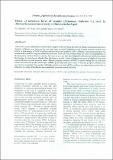| dc.contributor.author | PS Ojiambo, RD Narla, PO Ayiecho, JO Nyabundi | |
| dc.date.accessioned | 2020-08-12T07:36:45Z | |
| dc.date.available | 2020-08-12T07:36:45Z | |
| dc.date.issued | 1998 | |
| dc.identifier.uri | https://repository.maseno.ac.ke/handle/123456789/2006 | |
| dc.description.abstract | Alternaria sesami infection in sesame seed samples collected from farmers in Busia, Kakamega and Siaya districts of Kenya was detected by oat meal agar method. Infection levels in seed samples varied from 8.96% in Kakamega to 24.20% in Siaya with an infection level of 11.69% at Busia. Alternaria leafspot was monitored in plots having six seedborne infection levels (0-8%) to determine the effect of transmission of the fungus by seed on disease severity. Increase in percent leaf area blighted and percent defoliation fitted the Gompertz model more closely than the logistic model. Rates of disease increase in blighted leaf areas and defoliation as well as areas under disease progress curves (AUDPC) varied among the six infection levels. Seed inocula levels with larger AUDPC generally had faster rates of disease progress. Disease was most severe on plants from seeds with highest infection level of 8% and least … | en_US |
| dc.publisher | Faculty of Agriculture, University of Ruhuna. Kamburupitiya | en_US |
| dc.title | Effect of infection level of sesame (sesamum indicum L.) seed by alternaria sesami on severity of alternaria leaf spot | en_US |
| dc.type | Article | en_US |

